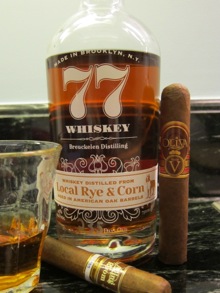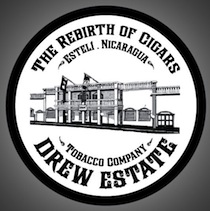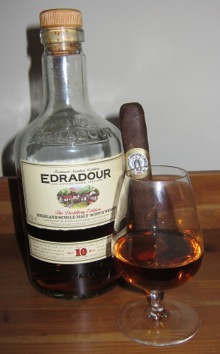Cigar Review: 7-20-4 Lancero
29 Nov 2012
I’ve come to believe that Kurt Kendall’s 7-20-4 brand represents the best of the latest variation of cigar entrepreneur. I’d put Gary Griffith of Emilio Cigars in a similar category. Both successfully ran cigar shops before working with first one cigar factory then others to create their own cigars, fueled primarily on their own passion. Both are small business cigar operations that keep the larger operations on their toes.
 While the brand has historic roots stretching back to 1874 (once over 50 million cigars were produced in New Hampshire each year), the newest version of 7-20-4 was introduced in 2008. The complex, five-nation blend is rolled in Honduras utilizing Nicaraguan, Honduran, and Mexican long-fillers, a Colombian binder, and a Brazilian mata fina wrapper.
While the brand has historic roots stretching back to 1874 (once over 50 million cigars were produced in New Hampshire each year), the newest version of 7-20-4 was introduced in 2008. The complex, five-nation blend is rolled in Honduras utilizing Nicaraguan, Honduran, and Mexican long-fillers, a Colombian binder, and a Brazilian mata fina wrapper.
This line has long been a favorite if mine, combining a reasonable price point ($5-7 each) with enjoyable flavors. The smallest size, the Dog Walker (4.25 x 40), is one I’ve particularly enjoyed as a small cigar that provides full flavors.
Given that, I was particularly interested to try the newest size of the 7-20-4 line, the Lancero (7.5 x 38). (Kendall has also introduced a Lancero in his 7-20-4 1874 Series blend.) In many, but certainly not all, cigars, the proportions of the Lancero yield the best representation of the blend with high amounts of wrapper flavor versus binder and filer. Kendall says he made the Lancero for himself, only deciding to make it a full production size after being encouraged by those he shared them with. So far about 500 boxes have been made.
Wrapped in a cedar sleeve, the Brazilian wrapper has a little shine and minimal veins. Once lit, I find a medium- to full-bodied combination of flavors with maple syrup, earth, and hints of coffee and chocolate. As it progresses, balanced yet intense notes emerge. The Lancero has excellent construction start to finish, with a even burn, stable ash, and an easy draw. That’s particularly notable given that some lanceros tend to have tight draws.
While I enjoy the 7-20-4 line in general, I think the smaller ring gauge formats are the best representations of the blend. The Dogwalker is a great small cigar, and the Lancero is an even better cigar, with it’s long and slender proportions. (The Gagger (6 x 60), on the other hand, is my least favorite of the line.) Oozing sweetness and intense flavors, the 7-20-4 Lancero is yet another example of a small ring gauge cigar demonstrating the best of a blend. That’s why it earns four and a half stogies out of five.

[To read more StogieGuys.com cigar reviews, please click here.]
photo credit: Stogie Guys

 Breukelen is made in Sunset Park, barely a mile from the neighborhood where I grew up. While I hadn’t heard of the operation until I saw it in a Park Slope wine shop, the distillery seems to have cut its teeth making small batch boutique gin and, more recently, moving into whiskey.
Breukelen is made in Sunset Park, barely a mile from the neighborhood where I grew up. While I hadn’t heard of the operation until I saw it in a Park Slope wine shop, the distillery seems to have cut its teeth making small batch boutique gin and, more recently, moving into whiskey.

 Drew Estate’s tagline is “the rebirth of cigars,” but the most impressive rebirth is that of Drew Estate itself. It’s easy to forget, but no cigar company has changed more in recent years than Drew Estate. I was recently searching for some information and found a thread on a message board consisting almost entirely of seasoned cigar smokers complaining about Drew Estate.
Drew Estate’s tagline is “the rebirth of cigars,” but the most impressive rebirth is that of Drew Estate itself. It’s easy to forget, but no cigar company has changed more in recent years than Drew Estate. I was recently searching for some information and found a thread on a message board consisting almost entirely of seasoned cigar smokers complaining about Drew Estate. Edradour is billed as “Scotland’s smallest distillery” and the numbers support the claim, although recently even smaller distilleries have opened. Edradour is a three-man operation (though I read they recently are down to two) and it produces only 95,000 liters per year, or 12 casks a week. (By comparison, Glenlivet, the best-selling scotch in the U.S., produces just under 6 million liters a year.) Interesting fact: With 100,000 visitors a year, Edradour is almost certainly the only whisky distillery in Scotland with more visitors than liters produced per year.
Edradour is billed as “Scotland’s smallest distillery” and the numbers support the claim, although recently even smaller distilleries have opened. Edradour is a three-man operation (though I read they recently are down to two) and it produces only 95,000 liters per year, or 12 casks a week. (By comparison, Glenlivet, the best-selling scotch in the U.S., produces just under 6 million liters a year.) Interesting fact: With 100,000 visitors a year, Edradour is almost certainly the only whisky distillery in Scotland with more visitors than liters produced per year.
 Patrick Ashby
Co-Founder & Editor in Chief
Patrick Ashby
Co-Founder & Editor in Chief Patrick Semmens
Co-Founder & Publisher
Patrick Semmens
Co-Founder & Publisher George Edmonson
Tampa Bureau Chief
George Edmonson
Tampa Bureau Chief